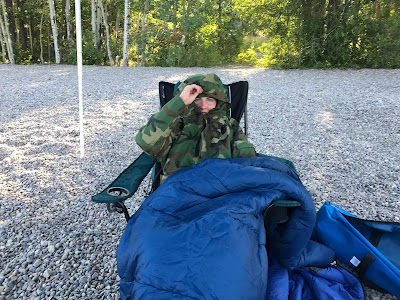Unfortunately he won’t be with us this time; he’s in college. But my wife and I are going.
 |
| My photo of the 2017 eclipse |
 |
| My photo of the 2017 eclipse |
Again, I checked historical weather records for cloud cover along the path of totality. This time it’s not great. The best place within the US appears to be in Texas. So that’s where we’re going. If I can believe the weather projections, there’s a 50-50 chance of clouds.
It was ridiculously hard to get a hotel reservation last time. This time we were able to get a room in Austin. So I’m planning to stay there the night before the eclipse, and check the weather forecasts for the next day to decide where to watch the eclipse. Afterward, my wife and I will start the long drive home to Virginia, with no particular plan for where to spend the night.
I’m undecided with respect to the location at which to watch the eclipse. I’m generally hoping to find a location somewhere close to the center line of the path of totality between Waco and Fredericksburg. But of course a few million other people probably have the same idea. We could just drive to the general area and look for a place to set up. But I wanted something a little more concrete as an option, not wanting to be stuck on the road somewhere in traffic unable to find a suitable place. I need a place where I can linger for several hours with a clear view to the south and access to a bathroom.
So I decided to make a day use reservation at a state park. I reviewed my options, selected several parks, made a rank-ordered list, and waited several weeks for the reservation window to open. I made an account on the web site. A few minutes before the window opened, I navigated through the reservation process up to the point where it was possible to actually make a reservation. I attempted to reserve at Lake Whitney, pressing the button seconds after the reservation window opened. The result: server error. Lots of others had the same idea. I tried repeatedly: more server errors, until all of the reservation slots were taken. It took less than a minute. I tried my second choice: Meridian State Park. I was able to make a reservation there. So I have a limited access location (hopefully not crowded), not on a highway, with bathrooms, where I can linger. It only cost me $10, so if I find a better place I’ll just abandon this plan.
I wanted a backup location. Meridian State Park looks like there isn’t a lot of room to park with a good view of the sky. I searched more. I made a reservation in Gatesville at the baseball field complex. There are parking lots, bathrooms, concessions, and not very many trees. I’m hoping I can get a good spot for a clear look at the sky.
I love a photographic challenge, and total solar eclipses are definitely a challenge. I need a better plan than I had in 2017. I got some acceptable results then, but I can do better now. I have better equipment. I have the experience of last time from which to learn. I’ve found better resources to help me make a better plan. Presuming I have a good location and sufficient time to set up, here’s my plan:
- Set up a GoPro to create a video of us as I go through the camera setup, wait for totality, watch eclipse, photograph all the way through the end of the partial phase, then tear down.
- Set up a DSLR on a tripod with a wide angle lens to capture the partial phases with an intervalometer. Switch to video right before totality; switch back to the intervalometer immediately after.
- Set up a second DSLR on a star tracker, use a laptop computer with a programmed shooting plan. Mostly ignore this one during the eclipse; let the automation do the job. The success of this one depends upon a good shooting script (using Eclipse Orchestrator) and a good polar alignment job. I tested the script and realized I needed a higher-capacity card. I’ve also practiced daytime polar alignment, with good results (the tracker keeps the sun centered).
- Set up a third DSLR on a tripod to shoot manually. This one is my best lens and my best camera. I’ll set an intervalometer to run during the partial phases so I only have to keep the sun in the field of view. During totality, and for the transitions into/out of totality, I’ll shoot manually, with a plan will leave a lot of time for me to just look at the sun.
So there’s my plan; now all I can do is hope for clear skies and trouble-free travels. In the meantime, I’ve practiced setting the cameras and computer and tracker up. I’ve discovered some issues that I’ve learned from. I know it won’t all go to plan, but I’m hoping I get it mostly right.
Wherever I end up, it won’t be as photogenic as in 2017, but that’s OK.
 |
| Our view while waiting for the 2017 eclipse |
 |
| My son said it was cold that morning before the sun came up |
No comments:
Post a Comment